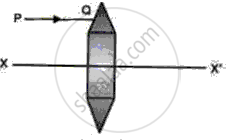Advertisements
Advertisements
प्रश्न
In your laboratory you trace the path of light rays through a glass slab for different values of angle of incidence (∠i) and in each case measure the values of the corresponding angle of refraction (∠r) and angle of emergence (∠e). On the basis of your observations your correct conclusion is:
(a) ∠i is more than ∠r, but nearly equal to ∠e
(b) ∠i is less then ∠r, but nearly equal to ∠e
(c) ∠i is more than ∠e, but nearly equal to ∠r
(d) ∠i is less than ∠e, but nearly equal to ∠r
उत्तर
(a) ∠i is less than ∠r but nearly equal to ∠e.

On entering a glass slab, the incident light gets refracted. According to Snell’s law, we get
`mu=sini/sinr`
For glass μ > 1
∴sinr < sini
or r < i
In refraction of light through a glass slab, the emergent ray is parallel to the incident ray. Thus, ∠i = ∠e.
APPEARS IN
संबंधित प्रश्न
Four students P, Q, R and S traced the path of a ray of light passing through a glass slab for an angle of incidence 40° and measured the angle of refraction. The values as measured them were 18°; 22°; 25° and 30° respectively. The student who has performed the experiment methodically is
(A) P
(B) Q
(C) R
(D) S
A ray of light passes from water to air. How does the speed of light change?
How can you bend light away from the normal?
Four students showed the following traces of the path of a ray of light passing through a rectangular glass slab.

The trace most likely to be correct is that of student
(A) I
(B) II
(C) III
(D) IV
Fig shows a lens as a combination of a glass block and two prisms.

(i) Name the lens formed by the combination.
(ii) what is the XX' called?
(iii) Complete the ray diagram and show the path of the incident ray PQ after passing through the lens.
(iv) The final emergent ray will either meet XX' at a point or appear to come from a point on XX'. what is the point called?
Why upper surface of water contained in a beaker and above eye level appears silvery?
State the factors on which the angle of deviation depends.
How is the refractive index of a medium related to its real depth and apparent depth?
Draw a diagram of a prism and label:
(i) the base,
(ii) the refracting surfaces,
(iii) the refracting edge,
(iv) the refracting angle in it.
